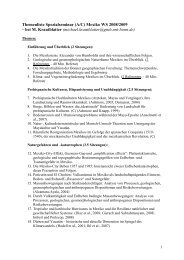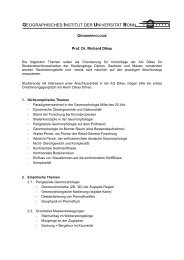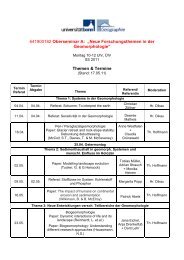Colluvial sediment in Central Europe
Colluvial sediment in Central Europe
Colluvial sediment in Central Europe
Create successful ePaper yourself
Turn your PDF publications into a flip-book with our unique Google optimized e-Paper software.
<strong>Colluvial</strong><br />
<strong>sediment</strong> <strong>in</strong><br />
<strong>Central</strong> <strong>Europe</strong><br />
Dr Thomas Hoffmann discusses his research which <strong>in</strong>vestigates colluvial <strong>sediment</strong> with the<br />
aim to further knowledge on the long-term impacts of human-<strong>in</strong>duced soil erosion <strong>in</strong> <strong>Europe</strong><br />
dr thomas hoffmann<br />
What are the chief goals of your project?<br />
To understand the impact of the first farmers <strong>in</strong><br />
<strong>Central</strong> <strong>Europe</strong> on soil erosion and degradation.<br />
We hope to achieve this by: i) quantify<strong>in</strong>g spatial<br />
variation <strong>in</strong> the onset of colluvial process along<br />
the trajectories of human migration pathways,<br />
and iii) develop<strong>in</strong>g a human impact proxy of<br />
colluvial hillslope systems.<br />
Could you def<strong>in</strong>e ‘colluvial <strong>sediment</strong>’ and it’s<br />
geomorphological significance?<br />
<strong>Colluvial</strong> <strong>sediment</strong>s are hillslope deposits, many<br />
of which are caused by anthropogenic soil<br />
erosion. A significant proportion of soil eroded<br />
on gently <strong>in</strong>cl<strong>in</strong>ed hillslopes is not exported <strong>in</strong>to<br />
river channels and the ocean, but is transported<br />
over a short distance and rema<strong>in</strong>s on hillslopes<br />
for several thousand years. Therefore, colluvial<br />
deposits can be directly l<strong>in</strong>ked to phases of<br />
<strong>in</strong>creased soil erosion and provide an effective<br />
means to reconstruct periods of <strong>in</strong>creased soil<br />
erosion <strong>in</strong> <strong>Central</strong> <strong>Europe</strong> s<strong>in</strong>ce the Neolithic<br />
(start<strong>in</strong>g 7,500 years ago).<br />
How did you <strong>in</strong>itially develop an <strong>in</strong>terest <strong>in</strong><br />
this research area?<br />
As a physical geographer, I have always been<br />
<strong>in</strong>terested <strong>in</strong> how humans impact on their<br />
natural environment. I was curious to know if<br />
humans have only very recently modified their<br />
environment or if substantial transitions from<br />
natural to human dom<strong>in</strong>ated environments<br />
already took place several thousand years ago.<br />
Liv<strong>in</strong>g <strong>in</strong> <strong>Central</strong> <strong>Europe</strong>, it was rather obvious<br />
that human-<strong>in</strong>duced soil erosion did not start<br />
dur<strong>in</strong>g the Industrial Revolution, but is em<strong>in</strong>ent<br />
s<strong>in</strong>ce the first farmers arrived <strong>in</strong> the fertile Loess<br />
countries of <strong>Central</strong> <strong>Europe</strong>.<br />
Could you provide an overview of the<br />
methods you are us<strong>in</strong>g to achieve your<br />
project’s aims?<br />
We use a <strong>sediment</strong> budget approach as an<br />
organis<strong>in</strong>g framework to synthesise case studies<br />
on colluvial <strong>sediment</strong>s. A <strong>sediment</strong> budget<br />
compares the sources, transport pathways<br />
and s<strong>in</strong>ks of eroded soil. It thus considers the<br />
<strong>in</strong>termediate <strong>sediment</strong> storages (eg. storage<br />
<strong>in</strong> colluvial footslopes, debris fans, floodpla<strong>in</strong>s<br />
and lakes) as <strong>sediment</strong>s travel from hillslopes<br />
to the sea, and takes <strong>in</strong>to account complex<br />
responses of soil erosion and transport<br />
result<strong>in</strong>g from external environmental changes<br />
and <strong>in</strong>ternal feedback, which are <strong>in</strong>tr<strong>in</strong>sic to<br />
<strong>sediment</strong> fluxes.<br />
The temporal evolution of <strong>sediment</strong> budget<br />
components <strong>in</strong> <strong>Central</strong> <strong>Europe</strong> is studied by<br />
compil<strong>in</strong>g a database of age estimates (eg.<br />
through radiocarbon and optically stimulated<br />
lum<strong>in</strong>escence) <strong>in</strong> different depositional<br />
environments. These dates are analysed <strong>in</strong><br />
terms of frequency distributions and chang<strong>in</strong>g<br />
nature of <strong>sediment</strong> accumulation rates.<br />
Have you made any <strong>in</strong>terest<strong>in</strong>g f<strong>in</strong>d<strong>in</strong>gs so<br />
far that you would like to highlight?<br />
Despite massive soil erosion <strong>in</strong> <strong>Central</strong><br />
<strong>Europe</strong> s<strong>in</strong>ce the Neolithic, only a fraction<br />
of eroded soils were transported beyond the<br />
hillslopes. The majority of the eroded soils<br />
are transported only a short distance and are<br />
deposited with<strong>in</strong> the eroded field or at the<br />
foot of the eroded hillslope. This is especially<br />
true for Neolithic land use, which was limited<br />
to small patches, with<strong>in</strong> a predom<strong>in</strong>antly<br />
forest covered landscape. The results suggest<br />
that soil erosion dur<strong>in</strong>g the Neolithic did<br />
not result <strong>in</strong> a significant soil degradation<br />
and decl<strong>in</strong>e of soil nutrients. Thus, it is very<br />
unlikely that soil erosion provides a critical<br />
boundary condition for regional human<br />
migration dur<strong>in</strong>g that period.<br />
How might your research contribute to a<br />
deeper understand<strong>in</strong>g of anthropological<br />
effects and global climate?<br />
Today, soil degradation affects 38 per cent<br />
of global cropland and thus has undesirable<br />
impacts on susta<strong>in</strong>able food production.<br />
Soil erosion, however, is not limited to the<br />
last decades. Much (pre)historical evidence<br />
<strong>in</strong>dicates that water erosion caused a<br />
substantial decl<strong>in</strong>e of food resources <strong>in</strong> ancient<br />
societies that may have been a critical driver<br />
of their collapse. Already, Plato commented<br />
on the deforestation of Attica: “What now<br />
rema<strong>in</strong>s compared with what then existed<br />
is like the skeleton of a sick man, all fat and<br />
soft earth hav<strong>in</strong>g wasted away, and only<br />
the bare framework of the land be<strong>in</strong>g left”.<br />
Therefore, we <strong>in</strong>tend to evaluate when and<br />
where anthropogenic soil erosion became a<br />
controll<strong>in</strong>g factor of human migration as a<br />
consequence of decl<strong>in</strong><strong>in</strong>g crop yields.<br />
It has been argued that early human<strong>in</strong>duced<br />
deforestation is a major cause<br />
of <strong>in</strong>creas<strong>in</strong>g atmospheric CO 2 start<strong>in</strong>g<br />
7,000 years ago. However, <strong>in</strong>creas<strong>in</strong>g soil<br />
erosion caused by early deforestation<br />
removes organic rich topsoils, which<br />
are stored <strong>in</strong> hillslope and floodpla<strong>in</strong><br />
deposits. Carbon burial, <strong>in</strong> conjunction<br />
with replacement of carbon on eroded<br />
sites, results <strong>in</strong> a net removal of CO 2 from<br />
the atmosphere and might potentially<br />
offset the effects of carbon emission of<br />
human-<strong>in</strong>duced deforestation. Ga<strong>in</strong><strong>in</strong>g a<br />
detailed knowledge of the mechanisms of<br />
soil erosion on the global carbon cycle is<br />
therefore imperative.<br />
www.researchmedia.eu 73
dr thomas hoffmann<br />
Understand<strong>in</strong>g the impacts of soil erosion<br />
Soil erosion by water rema<strong>in</strong>s the greatest global cause of soil degradation, yet the impact of (pre)historical<br />
land management on soil erosion is still poorly understood. Analys<strong>in</strong>g colluvial deposits may help us understand<br />
past and present human-environmental <strong>in</strong>teractions with respect to chang<strong>in</strong>g soil fertility and productivity<br />
Environmental change is an important<br />
topic, and one which is <strong>in</strong>creas<strong>in</strong>gly impossible<br />
to ignore. Whether this change is precipitated<br />
by human impacts or natural climatic factors<br />
is a highly contentious issue, particularly <strong>in</strong> the<br />
context of climate change politics. Increas<strong>in</strong>gly, the<br />
<strong>in</strong>terrelation of different human factors and natural<br />
forces is reassessed and re-evaluated. Needless<br />
to say, it is not simply a dichotomy between CO 2<br />
emissions and carbon mitigation <strong>in</strong>itiatives.<br />
Chang<strong>in</strong>g land use, for example, is also an important<br />
factor to be considered <strong>in</strong> any conversation around<br />
environmental change, and a project led by Dr<br />
Thomas Hoffmann suggests that the long term<br />
environmental impact of soil erosion is much<br />
greater than one might expect. Whether natural or<br />
human <strong>in</strong>duced, soil erosion mobilises organic-rich<br />
topsoil and can lead to the burial of organic carbon<br />
<strong>in</strong> terrestrial and aquatic ecosystems. Because of<br />
this, soil erosion can result <strong>in</strong> the degradation of<br />
land and reduction of soil fertility, and can therefore<br />
threaten the livelihoods of many who live off the<br />
land.<br />
In addition, however, the erosion and re-deposition<br />
of organic carbon attached to <strong>sediment</strong> is an<br />
imporant part of the global carbon cycle, yet a<br />
part which is poorly understood – particularly <strong>in</strong><br />
the context of historic, or prehistoric, <strong>in</strong>teractions<br />
between humans and the environment.<br />
LUCIFS & CRC 806<br />
This is where the Land Use and Climate Impacts on<br />
Fluvial Systems (LUCIFS) network comes <strong>in</strong>. As part<br />
of the Past Global changES (PAGES) programme,<br />
LUCIFS is chaired by Dr Thomas Hoffmann and<br />
supported by an <strong>in</strong>ternational cohort of top<br />
geoscientists, with the aim of seek<strong>in</strong>g to understand<br />
past <strong>in</strong>teractions between climate, human activity<br />
and fluvial systems.<br />
By utilis<strong>in</strong>g a geomorphological and<br />
<strong>sediment</strong>ological approach, LUCIFS aims to<br />
ga<strong>in</strong> a greater understand<strong>in</strong>g of the mid- to<br />
long-term impact of humans on the landscape.<br />
Hoffmann employs expertise from numerous<br />
discipl<strong>in</strong>es, <strong>in</strong>clud<strong>in</strong>g archaeology, paleo-botany,<br />
soil science and geomorphology, and believes<br />
that a multidiscipl<strong>in</strong>ary approach will lead to a<br />
better understand<strong>in</strong>g of the impact of human<br />
history on soil erosion and degradation. Through<br />
Hoffmann, LUCIFS has teamed up with CRC<br />
806 (Collaborative Research Centre 806 ’Our<br />
Way to <strong>Europe</strong>’) – a multidiscipl<strong>in</strong>ary research<br />
<strong>in</strong>itiative, br<strong>in</strong>g<strong>in</strong>g scientists together to research<br />
cooperatively on the complex <strong>in</strong>terrelation of<br />
climatic, environmental, and socio-cultural factors<br />
which drove (or enabled) the dispersal of Homo<br />
sapiens, or modern man, from Africa to <strong>Central</strong><br />
<strong>Europe</strong> and resulted <strong>in</strong> human <strong>in</strong>duced changes of<br />
the natural environment.<br />
Exam<strong>in</strong><strong>in</strong>g colluvial deposits<br />
As part of CRC 806’s aim to shed light on historic,<br />
or prehistoric, human-environmental <strong>in</strong>teractions,<br />
Hoffmann has led a LUCIFS project to analyse<br />
colluvial deposits across <strong>Central</strong> <strong>Europe</strong>. When soil<br />
erodes, either naturally or through agriculture, it<br />
rarely travels as far as the sea, but often builds up<br />
as deposits on hillslopes. S<strong>in</strong>ce colluvial <strong>sediment</strong><br />
can lie here for thousands of years, it can be dated<br />
to provide a picture of historic climatic conditions<br />
and land use practices. <strong>Colluvial</strong> <strong>sediment</strong> therefore<br />
has the potential to open the door to humanenvironmental<br />
<strong>in</strong>teractions from the Neolithic to<br />
the present day.<br />
In addition, quantify<strong>in</strong>g <strong>sediment</strong> storage has the<br />
potential to gauge the effects of related carbon<br />
storage on atmospheric CO 2 consumption, and<br />
could therefore <strong>in</strong>form current land use practices<br />
and carbon mitigation policy.<br />
Soil erosion can result <strong>in</strong><br />
the degradation of land and<br />
reduction of soil fertility, and can<br />
therefore threaten the livelihoods<br />
of many who live off the land<br />
Driv<strong>in</strong>g the project forwards, Hoffmann is<br />
coord<strong>in</strong>at<strong>in</strong>g various research methods to arrive<br />
at as accurate a quantification of past humanenvironment<br />
<strong>in</strong>teractions as possible. These<br />
methods <strong>in</strong>clude <strong>sediment</strong> budget<strong>in</strong>g on different<br />
spacial and temporal scales, spatial modell<strong>in</strong>g with<br />
GIS and geostatistics, mathematical and numerical<br />
modell<strong>in</strong>g, and geophysics. Key to the project’s<br />
approach is provid<strong>in</strong>g data on a dynamic large<br />
scale. “Research on colluvial deposits is traditionally<br />
focused on local archaeological sites or neighbour<strong>in</strong>g<br />
hillslopes,” expla<strong>in</strong>s Hoffmann. “Soil erosion <strong>in</strong><br />
prehistoric times, however, is very scattered due to<br />
disordered land use activity, caus<strong>in</strong>g a high spatial<br />
variability of colluvial deposits.”<br />
As a result, Hoffmann’s team is br<strong>in</strong>g<strong>in</strong>g together a<br />
large dataset from across <strong>Central</strong> <strong>Europe</strong> to try and<br />
ga<strong>in</strong> a more complete picture of colluvial <strong>sediment</strong><br />
and therefore also historic, and prehistoric, humanenvironmental<br />
<strong>in</strong>teractions.<br />
Ris<strong>in</strong>g to the challenge<br />
Their research is not without obstacles: “On<br />
steep terra<strong>in</strong>, deposition of eroded soil is typically<br />
controlled by slope steepness and curvature, and<br />
can therefore be predicted from digital elevation<br />
models,” Hoffmann exam<strong>in</strong>es. On gentle terra<strong>in</strong><br />
74 International <strong>in</strong>novation
however, eroded <strong>sediment</strong> is generally deposited<br />
at local features such as field borders, roads and<br />
shallow depressions, which block the down-slope<br />
surface water flow. “These features are not static,<br />
but change over time, due to chang<strong>in</strong>g land use<br />
practises, caus<strong>in</strong>g a chang<strong>in</strong>g pattern of colluvial<br />
deposition <strong>in</strong> different land use periods. These<br />
features are difficult to reconstruct and thus add a<br />
cont<strong>in</strong>gent dimension to the spatial and temporal<br />
pattern of colluvial accumulation.”<br />
One further challenge has been encountered <strong>in</strong><br />
the form of colluvial deposits hav<strong>in</strong>g a limited<br />
preservation potential. Whereas lakes provide<br />
a long-term <strong>sediment</strong>ary s<strong>in</strong>k with very limited<br />
post-depositional modification, colluvial deposits<br />
are subject to erosion <strong>in</strong> subsequent storm events.<br />
Consequently, prehistoric colluvial deposits are<br />
less frequent than younger deposits and they<br />
are less likely to be detected. On account of<br />
this bias, Hoffmann believes that we may have<br />
underestimated human-<strong>in</strong>duced soil erosion dur<strong>in</strong>g<br />
early prehistoric times.<br />
As well as benefit<strong>in</strong>g from multidiscipl<strong>in</strong>ary<br />
cooperation and the <strong>in</strong>volvement of the LUCIFS<br />
network and CRC 806, this project has been<br />
helped by a number of advances <strong>in</strong> geoscience.<br />
Hoffmann comments: “Our understand<strong>in</strong>g of<br />
temporal changes has greatly advanced through<br />
the development and advancement of several<br />
dat<strong>in</strong>g techniques, of which radiocarbon dat<strong>in</strong>g and<br />
optically stimulated lum<strong>in</strong>escence (OSL) has been<br />
most promis<strong>in</strong>g”.<br />
Yet the research also benefits from recent<br />
developments <strong>in</strong> data handl<strong>in</strong>g and the (re-)<br />
construction of large scale datasets. Large<br />
scale maps of historic and prehistoric land use<br />
have recently become available. Coupled with<br />
extensive high resolution digital elevation models,<br />
Hoffmann and his team have been able to study<br />
soil degradation of early cultural epochs on a much<br />
wider scale.<br />
Future focus<br />
The results of the project so far suggest that limited<br />
<strong>sediment</strong> delivery from hillslopes to river channels<br />
and the long-term effects of carbon burial <strong>in</strong> human<br />
<strong>in</strong>duced <strong>sediment</strong> is of significant importance.<br />
Through collaboration with the LUCIFS network,<br />
Outcrop with 3 m thick colluvial <strong>sediment</strong>s <strong>in</strong> the loess<br />
lower Rh<strong>in</strong>e (GER). The dark brown layer on top shows<br />
a young colluvium deposited s<strong>in</strong>ce 1950AD, the light<br />
brown layers were depsoited s<strong>in</strong>ce the Bronze age.<br />
Hoffmann has reassessed the relevance of carbon<br />
burial <strong>in</strong> hillslopes and floodpla<strong>in</strong>s and called for<br />
their <strong>in</strong>clusion <strong>in</strong> carbon budgets.<br />
Look<strong>in</strong>g forwards, not only is the project likely to<br />
<strong>in</strong>form us about our past and the impacts of humanenvironmental<br />
<strong>in</strong>teractions on Holocene human<br />
migration, but it also has a present relevance. By<br />
<strong>in</strong>vestigat<strong>in</strong>g the factors that played a role <strong>in</strong> the<br />
human-environmental <strong>in</strong>teractions of our early<br />
ancestors, the projects could contribute towards<br />
a greater understand<strong>in</strong>g of environmental change,<br />
and feed <strong>in</strong>to current and future land and river<br />
management policy.<br />
The project’s next landmark is the Open PAGES<br />
Focus 4 Workshop ’Towards a more accurate<br />
quantification of human-environment <strong>in</strong>teractions<br />
<strong>in</strong> the past Human-Climate-Ecosystem<br />
Interactions’, which will be held <strong>in</strong> Leuven,<br />
Belgium, 3-7 February, 2014. More <strong>in</strong>formation<br />
about the workshop can be found at http://ees.<br />
kuleuven.be/pages/.<br />
Intelligence<br />
Human Impact on <strong>Colluvial</strong><br />
<strong>sediment</strong> storages <strong>in</strong> <strong>Europe</strong> s<strong>in</strong>ce<br />
the Neolithic<br />
OBJECTIVES<br />
To improve the understand<strong>in</strong>g of human<br />
impact on soil degradation and soil erosion<br />
and it’s feedback to human migration dur<strong>in</strong>g<br />
the past 7,500 years <strong>in</strong> <strong>Central</strong> <strong>Europe</strong>.<br />
KEY COLLABORATORS<br />
Professor Richard Dikau (University of<br />
Bonn) • Professor Andreas Lang (University<br />
of Liverpool) • Professor Bob Wasson<br />
(University of Signapore) • Dr Gert Vertraeten<br />
(University of Leuven) • Professor Oliver<br />
Korup (University of Potsdam) • Professor<br />
Andreas Zimmermann (University Cologne)<br />
• Professor Renate Gerlach (LVR, Bonn) •<br />
Professor Wulf Amelung (University of Bonn)<br />
• members of the CRC 806 (Universities of<br />
Cologne, Bonn and Aachen)<br />
FUNDING<br />
A 36-month project was founded by the<br />
German Research Foundation as part of the<br />
Collaborative Research Centre 806 ‘Our way<br />
to <strong>Europe</strong>: Culture-Environment Interaction<br />
and Human Mobility <strong>in</strong> the Late Quaternary’<br />
(SFB 806/1)<br />
CONTACT<br />
Dr Thomas Hoffman<br />
Project Coord<strong>in</strong>ator<br />
University of Bonn<br />
Department of Geography<br />
Meckenheimer Allee 166<br />
53115 Bonn, Germany<br />
T +49 228 73 7507<br />
E thomas.hoffmann@uni-bonn.de<br />
www.geomorphology.uni-bonn.de/<br />
persons/hoffmann<br />
Thomas Hoffmann is a geomorphologist<br />
at the Department of Geography, University<br />
of Bonn. He is the leader of the PAGES Focus<br />
4 work<strong>in</strong>g group on soils and <strong>sediment</strong>s. The<br />
ma<strong>in</strong> field of his research is on soil erosion and<br />
<strong>sediment</strong> fluxes through river systems.<br />
www.researchmedia.eu 75








